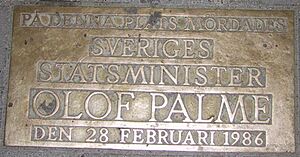History of Sweden (1967–1991) facts for kids
This article explores important events in the history of Sweden from the late 1960s to 1991. You'll learn about big changes in politics, society, and how Sweden interacted with the rest of the world during these years.
Contents
Sweden's Changing Ideas (1960s-1970s)
In the mid-1960s, many young people in Sweden became interested in new political ideas. They wanted to see big changes in society. There were some well-known events, like the Båstad riots and students taking over a building at Stockholm University. These events showed strong feelings, but luckily, no one was seriously hurt.
People started talking a lot about "solidarity" and "awareness." This meant caring for others and understanding big problems. These ideas spread from students to groups working for social change. Soon, the media and even the government, led by Prime Minister Olof Palme, started to support these ideas.
Standing Up for What's Right
By the early 1970s, Sweden was speaking out against unfairness and war in other countries. For example, they protested against the treatment of people in South Africa and the Vietnam War. In 1972, Prime Minister Palme strongly criticized bombings in Vietnam. He even compared them to terrible acts from World War II.
Sweden gave steady support to groups like the ANC in South Africa and the FNL in Vietnam. This support included words, popular backing, and financial help. After Vietnam became one country again in 1975, Sweden even helped build a modern factory there.
Changes to Sweden's Government Rules
During the 1970s, Sweden's constitution (the main rules for the government) was changed several times. In 1971, the Riksdag (Sweden's parliament) became simpler, with only one main group of lawmakers.
Then, in 1974, a new constitution was made. This new rule meant the monarch (the king or queen) no longer had any political power. This was the final step in a long process that had been happening for many years. Even though the king or queen doesn't have political power, Sweden still has a monarchy today.
Caring for the Environment and Nuclear Power
The 1970s and 1980s saw a rise in environmentalism in Sweden. People became more worried about protecting nature. In 1980, a special vote was held about Swedish nuclear power. The result suggested that Sweden should stop using nuclear power by 2010.
However, in 1986, the Chernobyl disaster happened far away. This accident caused a lot of radioactive fallout to spread, even reaching Sweden. This made people even more concerned about nuclear power.
Even with the plan to stop nuclear power, most of Sweden's nuclear reactors were still running many years later. This showed that stopping them completely was harder than expected. The Green Party was formed in 1981 because of these environmental concerns. They later entered the Riksdag in 1988.
New Leaders and Challenges (1976-1982)
In 1976, something big happened in Swedish politics. After nearly 50 years of the Social Democrats leading the country, a new group of parties won the election. This was a mix of liberal and right-wing parties. Olof Palme stepped down as Prime Minister, and Thorbjörn Fälldin took his place. Fälldin was from the Centre Party, which used to represent farmers but had started to include environmental ideas.
Over the next six years, Sweden had four different governments. These governments were made up of some or all of the parties that won in 1976. They faced big challenges, like dealing with energy issues and a struggling economy. The last government during this time, again led by Fälldin, found it hard to solve these problems. They didn't have strong support in parliament or from the voters.
Because of this, they faced criticism from both the Social Democrats and the trade unions. They also faced criticism from the Moderate Party, which was becoming more focused on free markets. In the 1982 elections, Fälldin's government was defeated, and Olof Palme returned as Prime Minister.
Mysterious Submarines in Swedish Waters
During the 1980s, there were several times when foreign submarines, likely from the Soviet Union, entered Swedish waters without permission. One famous event happened in late 1981. A Soviet submarine, the U 137, got stuck on the seabed near a naval base in Karlskrona. This became huge news.
At the time, it was kept secret, but nuclear activity was detected on board the submarine. This was reported to Prime Minister Fälldin while the submarine was still stuck. This incident changed how Sweden viewed the Soviet Union and its own defense. It also affected Sweden's place in the Cold War.
The Assassination of Olof Palme (1986)
On February 28, 1986, Prime Minister Olof Palme was tragically murdered. He was walking on the streets of Stockholm with his wife when it happened. This crime was a huge shock to Sweden. Many people describe it as a "national trauma" or the moment Sweden "lost its innocence."
A man named Christer Pettersson was suspected of the murder and was found guilty at first. However, this decision was later changed on appeal because the weapon used was never found. Pettersson passed away in 2004.
After Olof Palme's death, his deputy, Ingvar Carlsson, became the new Prime Minister.


